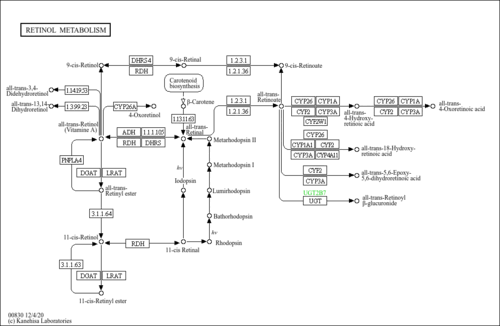| General References | - Gylling H, Relas H, Miettinen HE, Radhakrishnan R, Miettinen TA: Delayed postprandial retinyl palmitate and squalene removal in a patient heterozygous for apolipoprotein A-IFIN mutation (Leu 159-->Arg) and low HDL cholesterol level without coronary artery disease. Atherosclerosis. 1996 Dec 20;127(2):239-43. [PubMed:9125314 ]
- Relas H, Gylling H, Miettinen TA: Effect of stanol ester on postabsorptive squalene and retinyl palmitate. Metabolism. 2000 Apr;49(4):473-8. [PubMed:10778871 ]
- Antille C, Tran C, Sorg O, Carraux P, Didierjean L, Saurat JH: Vitamin A exerts a photoprotective action in skin by absorbing ultraviolet B radiation. J Invest Dermatol. 2003 Nov;121(5):1163-7. [PubMed:14708621 ]
- Epler KS, Ziegler RG, Craft NE: Liquid chromatographic method for the determination of carotenoids, retinoids and tocopherols in human serum and in food. J Chromatogr. 1993 Sep 8;619(1):37-48. [PubMed:8245162 ]
- Ribaya-Mercado JD, Blanco MC, Fox JG, Russell RM: High concentrations of vitamin A esters circulate primarily as retinyl stearate and are stored primarily as retinyl palmitate in ferret tissues. J Am Coll Nutr. 1994 Feb;13(1):83-6. [PubMed:8157860 ]
- Thomas JB, Kline MC, Schiller SB, Ellerbe PM, Sniegoski LT, Duewer DL, Sharpless KE: Certification of fat-soluble vitamins, carotenoids, and cholesterol in human serum: Standard Reference Material 968b. Anal Bioanal Chem. 1996 Aug;356(1):1-9. [PubMed:15045249 ]
- Fernandez-Miranda C, Cancelas P, Sanz M, Porres A, Gamez Gerique J: Influence of apolipoprotein-E phenotypes on postprandial lipoprotein metabolism after three different fat loads. Nutrition. 2001 Jul-Aug;17(7-8):529-33. [PubMed:11448569 ]
- Weintraub M, Grosskopf I, Trostanesky Y, Charach G, Rubinstein A, Stern N: Thyroxine replacement therapy enhances clearance of chylomicron remnants in patients with hypothyroidism. J Clin Endocrinol Metab. 1999 Jul;84(7):2532-6. [PubMed:10404832 ]
- Lindstrom MB, Sternby B, Borgstrom B: Concerted action of human carboxyl ester lipase and pancreatic lipase during lipid digestion in vitro: importance of the physicochemical state of the substrate. Biochim Biophys Acta. 1988 Mar 25;959(2):178-84. [PubMed:3349096 ]
- Gimeno A, Zaragoza R, Vivo-Sese I, Vina JR, Miralles VJ: Retinol, at concentrations greater than the physiological limit, induces oxidative stress and apoptosis in human dermal fibroblasts. Exp Dermatol. 2004 Jan;13(1):45-54. [PubMed:15009115 ]
- Kobayashi TK, Tsubota K, Takamura E, Sawa M, Ohashi Y, Usui M: Effect of retinol palmitate as a treatment for dry eye: a cytological evaluation. Ophthalmologica. 1997;211(6):358-61. [PubMed:9380354 ]
- Foger B, Drexel H, Hopferwieser T, Miesenbock G, Ritsch A, Lechleitner M, Trobinger G, Patsch JR: Fenofibrate improves postprandial chylomicron clearance in II B hyperlipoproteinemia. Clin Investig. 1994 Mar;72(4):294-301. [PubMed:8043977 ]
- Van Lieshout M, West CE, Van De Bovenkamp P, Wang Y, Sun Y, Van Breemen RB, Muhilal DP, Verhoeven MA, Creemers AF, Lugtenburg J: Extraction of carotenoids from feces, enabling the bioavailability of beta-carotene to be studied in Indonesian children. J Agric Food Chem. 2003 Aug 13;51(17):5123-30. [PubMed:12903979 ]
- Zampelas A, Ah-Sing E, Chakraboraty J, Murphy M, Peel A, Wright J, Williams CM: The use of retinyl palmitate to measure clearance of chylomicrons and chylomicron remnants following meals of different fatty acid compositions. Biochem Soc Trans. 1993 May;21(2):137S. [PubMed:8359391 ]
- Hartmann S, Froescheis O, Ringenbach F, Wyss R, Bucheli F, Bischof S, Bausch J, Wiegand UW: Determination of retinol and retinyl esters in human plasma by high-performance liquid chromatography with automated column switching and ultraviolet detection. J Chromatogr B Biomed Sci Appl. 2001 Feb 25;751(2):265-75. [PubMed:11236082 ]
- Tzimas G, Collins MD, Burgin H, Hummler H, Nau H: Embryotoxic doses of vitamin A to rabbits result in low plasma but high embryonic concentrations of all-trans-retinoic acid: risk of vitamin A exposure in humans. J Nutr. 1996 Sep;126(9):2159-71. [PubMed:8814204 ]
- Guerci B, Paul JL, Hadjadj S, Durlach V, Verges B, Attia N, Girard-Globa A, Drouin P: Analysis of the postprandial lipid metabolism: use of a 3-point test. Diabetes Metab. 2001 Sep;27(4 Pt 1):449-57. [PubMed:11547218 ]
- de Bruin TW, Brouwer CB, van Linde-Sibenius Trip M, Jansen H, Erkelens DW: Different postprandial metabolism of olive oil and soybean oil: a possible mechanism of the high-density lipoprotein conserving effect of olive oil. Am J Clin Nutr. 1993 Oct;58(4):477-83. [PubMed:8379502 ]
- Martins IJ, Hopkins L, Joll CA, Redgrave TG: Interactions between model triacylglycerol-rich lipoproteins and high-density lipoproteins in rat, rabbit and man. Biochim Biophys Acta. 1991 Feb 5;1081(3):328-38. [PubMed:1998751 ]
- Schindler R, Klopp A: Transport of esterified retinol in fasting human blood. Int J Vitam Nutr Res. 1986;56(1):21-7. [PubMed:3710714 ]
| Show more...
|---|
